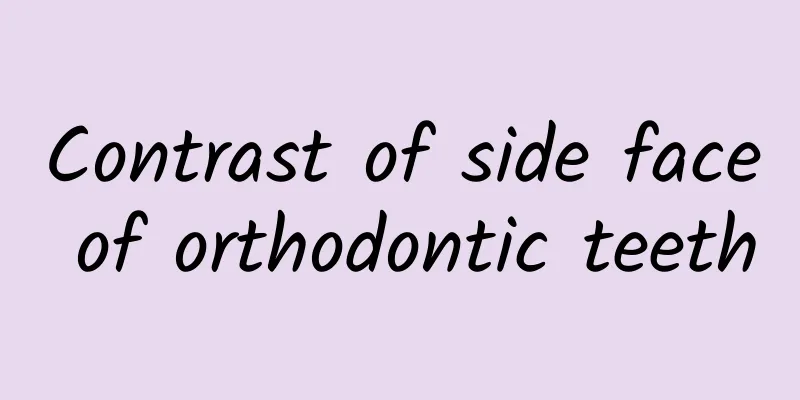Contrast of side face of orthodontic teeth

|
Dental aesthetics is the biggest problem that bothers people. Because many people now have bad oral habits or bad eating habits, they have various problems with their teeth, such as protruding teeth, sparse teeth, malocclusion, etc. These problems usually require orthodontic treatment. Below, we will introduce you to the relevant knowledge about orthodontics in detail! 1. The best time for orthodontic treatment 1. Primary teeth period (3 to 5 years old). The main purpose of correction is to promote the normal development of children's maxillofacial region. During this period, the main targets are malocclusions such as deciduous teeth crossbite (i.e. overbite), mandibular protrusion, posterior teeth crossbite, etc. that hinder the normal development of the maxillofacial region. It also promptly corrects bad habits that affect the normal function of the oral cavity, such as tongue sticking out and lip biting, to prevent further occurrence of malocclusion. 2. Tooth replacement period (girls: 8-10 years old, boys: 9-12 years old). Generally, there is no need to correct the local malocclusion that occurs during this period. However, for bad habits such as lip biting, tongue sticking out, and mandibular protrusion, or abnormal facial shape, anterior crossbite, functional mandibular retrusion, and abnormal relationship between the upper and lower jaws, it is often necessary to go to the hospital to see an orthodontic specialist for examination in time to determine whether it is a dental, functional, or skeletal malocclusion in order to clarify the treatment plan. 3. Permanent teeth period (girls: 11-14 years old, boys: 13-15 years old). Permanent dentition begins to form around the age of 12. Once malocclusion occurs at this time, it will not disappear automatically and can only be corrected through treatment by an orthodontic specialist. This period is the best time to correct malocclusion in children, with the best effect. All types of malocclusion can be corrected with orthodontic treatment. 2. Age Limit Adults have more limitations when it comes to receiving comprehensive orthodontic treatment than children. If the problem of tooth bite is caused by the underdevelopment of the upper and lower jaws, since the face and bones of an adult have basically been formed, it must be cured through orthodontic treatment. Only by combining orthodontics and maxillofacial surgery can deviations in jaw development in adults be corrected. Functional braces, which are used to correct abnormal jaw bone development in children, are generally not successful in adults. As society develops, people's requirements for quality of life are gradually increasing, and more and more adults are seeking orthodontic treatment to improve their smiles, correct their tooth bite or correct other problems caused by injuries, diseases or long-term neglect of oral care. Today's society pays more attention to personal image and health. Having a pleasant smile and neat teeth can increase your confidence. A healthy, beautiful smile can boost self-confidence at any age. Healthy teeth can be moved at any age. However, because the physiological metabolism of adults is not as active as that of young patients, and the oral environment is more complex than that of young patients, the difficulty and time required for orthodontic treatment will increase to a certain extent. Of course, because the facial bones of adults no longer grow, some serious malocclusion problems cannot be corrected with braces alone. Sometimes they require maxillofacial surgery combined with orthodontic treatment to solve them. 3. Indications 1. Patients with crowded teeth: The teeth are pushed in and out, which is unsightly, difficult to clean, prone to caries, easy to form tartar, and lead to periodontal disease. 2. Anterior crossbite is also known as "underbite", which is characterized by the lower front teeth biting outside the upper front teeth. Some people only have crossbite of the teeth; some people not only have crossbite of the teeth, but also have facial bone deformities, which is called skeletal crossbite, characterized by insufficient development of the maxillary bone (retrusion) and excessive development of the mandibular bone (protrusion), resulting in a depression in the middle of the face and a crescent-shaped profile, affecting appearance and function. 3. Patients with diastematous diseases, characterized by excessive gaps between teeth. 4. Deep overbite: also known as "protruding teeth", some of which are only manifested as protruding upper front teeth or inverted lower front teeth; others are skeletal deformities. Some of these people have upper front teeth and upper gums that protrude too far forward, while the chin is retracted behind the upper lip, or there is no chin at all. 5. Bimaxillary protrusion, or protrusion of the upper and lower front teeth, causing lip protrusion, and the patient has to use force to close the lips, and the lips are open and the teeth are exposed. 6. Crossbite and lockbite of posterior teeth: affect chewing function and may cause maxillary and mandibular deformities in the long term. 7. Patients with deep overbite (front teeth bite too deeply): the lower front teeth cannot be seen when biting; some people also have bone deformities, which manifests as a short lower face. This deformity can easily injure the upper gums and lead to periodontitis of the front teeth and facial joint diseases. |
<<: Are there any side effects of the contraceptive injection?
>>: What are the symptoms of Yin blood deficiency?
Recommend
What is the function of venous valves?
There are blood vessels distributed throughout ou...
What causes thick and greasy tongue coating? What does it relate to?
Nowadays, some people go to the doctor because of...
What to eat to quit smoking
Smoking is harmful to the body and has no benefit...
Is it okay for babies to get calcium injections?
If the baby is not severely calcium deficient, ca...
Symptoms of breast edema during lactation
There are great differences in the body structure...
What to do if the inside of the mouth hurts
Pain inside the mouth is often caused by ulcers, ...
What are the emergency measures for myocardial infarction?
Myocardial infarction, which we call myocardial i...
What does a thin pulse mean in Chinese medicine?
When treating diseases, TCM pays the most attenti...
Blindly following cupping therapy will only make things worse
Young people are obsessed with traditional Chines...
Can facial fire therapy remove acne?
Fire therapy for the face may seem like a very da...
Introduction to the clinical symptoms of cataract
If you want to effectively treat and reduce the i...
When dampness is heavy, what Chinese medicine can be used to regulate
According to the theory of traditional Chinese me...
Pain at the junction of the jaw and neck
There are actually many lymphatic systems in our ...
Hemorrhoids always want to defecate
Hemorrhoids are actually a very common disease. P...
Chinese medicine for prostate
The prostate is an important part of the male rep...









